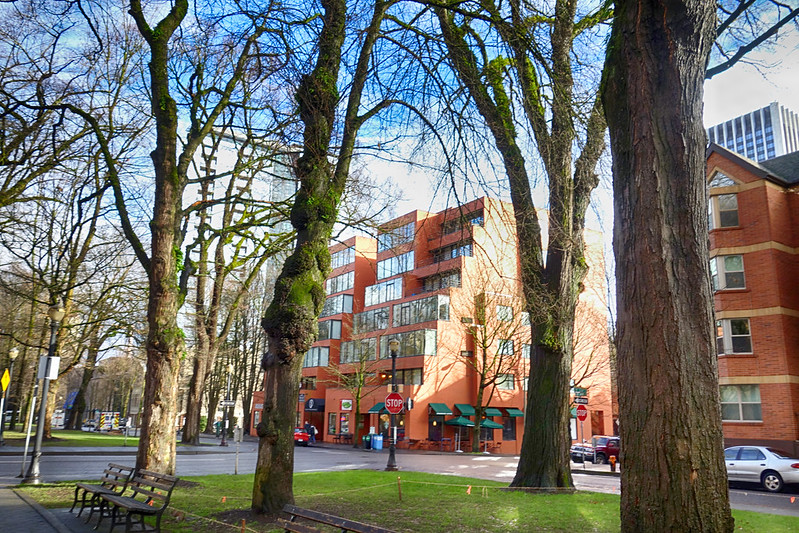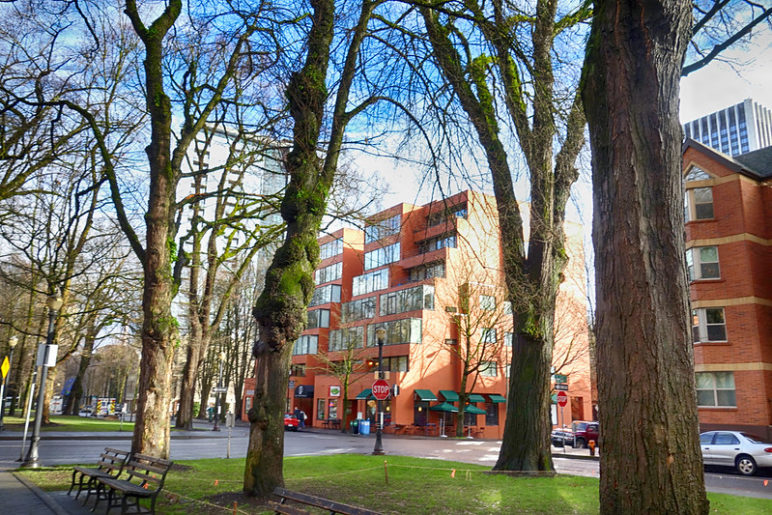Author’s note: Based on our research into the proposal’s effects, Sightline Institute has endorsed ballot measure 26-228. Read on for details about the measure and highlights of our research.
Major changes may be coming to Portland City Hall soon, courtesy of the city-appointed volunteer Charter Commission and the will of Portlanders as expressed at the ballot box this fall. After two years of research and public input, Charter Commission members proposed ballot measure 26-228, an important change to Portland’s founding document that would improve the city’s form of government and elections.
Among other changes (which you can read about in our FAQ or the City’s), ballot measure 26-228 would introduce multi-member districts. The city would be portioned into four equally populated geographic regions that each elect three city councilors. Here are ten things you should know about multi-member districts before you vote on the charter proposal.
1. You’re already using them
You heard me right: every Portlander is already living in a multi-member district system. Portland’s four city commissioners are elected in a multi-member district that encompasses the whole city. In the US Senate, there are 50 districts (states), each represented by two senators.1 And until 1972, Oregon itself used multi-member districts to elect its state legislature. Less populous counties were combined until enough people were included to warrant a single House or Senate seat,2 and larger counties elected multiple legislators to represent the entire county.3 Multi-member districts are also used in Anchorage, Alaska; Spokane, Washington; the Washington state House of Representatives; and many other places around the world.
2. There are many different ways to elect the members
Election systems require a ton of decisions, and different places often make different combinations of those decisions. If voters approve measure 26-228, Portland’s four districts of three councilors each would use a multi-winner ranked choice voting system. Cambridge, Massachusetts, also uses multi-winner ranked choice voting to elect its citywide council. In Portland’s current city commissioner system, the US Senate, and the old Oregon legislative system, candidates run for numbered positions and voters choose a single representative for each seat (single-winner races).4 Next door in Lake Oswego, voters select three candidates from a single pool on their ballot, and the top three vote-getters are elected to the citywide council. Similar systems, called “bloc voting,“ are used in more than 100 other Oregon cities.
3. Some ways have been used to exclude smaller voter blocs…
The different methods of electing multiple representatives all have pros and cons. Single-winner races and bloc voting are both winner-take-all systems.5 Portland currently uses a citywide winner-take-all system, meaning that a group of voters that makes up 50 percent (plus one) of the vote can elect all four commissioners and the mayor. Winner-take-all systems like this can lock any smaller group of voters out of winning any representation, whether used in at-large, single-member district, or multi-member district systems.
For example, before the Civil Rights Movement, some Southern states used winner-take-all multi-member districts to prevent Black voters from electing their preferred candidates to the US House of Representatives. In states that elected their House delegations as one big multi-member district, white majorities were able to win every single seat and leave Black voters without representation. In an attempt to remedy this, Congress banned all types of multi-member districts for the US House of Representatives in 1967. This successfully prevented states from using statewide winner-take-all systems to elect all of their representatives, but it also blocked states from using the much more democratic proportional system that Portland has the chance to implement this November.
4. …while others are global best practices in democracy
Proportional representation systems stand in stark contrast to winner-take-all systems and are the most common type of election system worldwide. This is the kind of multi-member district that Portland would use, implemented through multi-winner ranked choice voting.
Proportional systems elect councils that reflect voters’ support for different ideas. If one set of candidates gets about 60 percent of the vote, they’ll get about 60 percent of the seats. This preserves majority rule while also allowing fair representation for political minority groups: say, climate advocates, parents of school-age children, people of color, renters, seniors, transit riders, and any other group that makes up less than half of a district. In order for votes to proportionally translate into seats, you need to have a multi-member system (either citywide or in districts).
Since Portland’s ballot measure 26-228 includes proportional multi-member districts, we’ll focus on those from here on.
5. They give a fair voice to voters of color in Portland
At-large, winner-take-all voting systems, like Portland currently uses, almost always lock out the voices of people of color when they are outnumbered by white voters. Some cities, with different settlement patterns from Portland’s, may be able to improve representation by implementing single-member districts, where a few “majority-minority” districts are drawn that let voters of color elect candidates of their choice. But these aren’t a good fit for Portland, where white voters outnumber people of color across every region of the city. In fact, leading elections research group MGGG Redistricting Lab, at Tufts University, found that it’s impossible to draw any districts in Portland where people of color make up a majority. But because proportional systems give some representation to smaller political groups as well as larger ones, ballot measure 26-228 would give voters of color the opportunity to elect their preferred candidates in some of Portland’s multi-member districts.
6. They’re a better reflection of what the voters want
Unlike the majoritarian systems mentioned earlier, proportional systems give a fair shake to any minority group of voters. They’re a much better reflection of the actual voice and interests of voters. When the only outcome is that a single candidate wins a single seat, everything comes down to a binary choice: your candidate wins or loses, and 51 percent of the vote gets you everything, while 49 percent gets you nothing.
With the multi-member system proposed for Portland, it’s much harder to be completely locked in or locked out of power. A group of voters who made up just 25 percent (plus one) of the electorate in a district would win one seat of the three available. If that group constituted 50 percent (plus one), it would win two seats. But it’d have to encompass fully 75 percent (plus one) to control all three seats.
7. They give more voters a voice on city council
Because proportional multi-member districts represent voters’ preferences more closely, more voters see a candidate they like on the city council. Portland’s current winner-take-all elections mean that up to half of voters can be represented by candidates they didn’t mark their ballots for. But in cities using proportional representation, like Cambridge, Massachusetts, as many as 75 percent of voters have their favorite candidate elected, and up to 90 percent have their first or second choice elected.
8. They resist gerrymandering
Some opponents of the Charter Commission’s proposal would rather see Portland move to single-member districts for electing City Council. Single-member districts, however, are particularly vulnerable to gerrymandering. Map drawers can “crack” a group of voters into multiple districts so they can’t elect their preferred candidates anywhere, or they can “pack” a group of voters into a single district where the excess votes aren’t needed. This works because single-member districts are a pretty poor reflection of people’s votes. The only line that matters is 50 percent, and voters either get 100 percent or 0 percent of the representation if they land on either side of that line.
But because proportional multi-member districts allow for fair representation of minority political groups, it’s much harder to draw a district that dilutes the voting power of one group without increasing their voting power in a neighboring district. The lines just don’t matter as much because outcomes in each district are a much closer representation of what voters actually want.
9. They give voters local representation without assuming that’s the only thing people need
Which would you rather have: a representative who lives next door to you that disagrees with you on most things, or a representative two neighborhoods over who shares more of your beliefs and concerns? Trick question: multi-member districts let you vote for either, depending on what your priorities are.
If you live in Lents and decide that neighborhood-scale concerns are most important to you, you can vote with your closest neighbors for a candidate who understands those concerns and will represent your interests. Or if something farther-reaching is your biggest issue, you can band together with residents from all across East Portland to elect a councilor that speaks to that more regional or citywide issue.6 Both of these scenarios happen in Cambridge’s citywide proportional elections. Some councilors run up the vote tally in certain neighborhoods and skip campaigning in others, while other candidates earn votes here and there from all across the city to build their coalition.
10. They balance neighborhood and citywide concerns
At the end of the day, multi-member districts are one middle ground between at-large elections, Portland’s current flawed system, and a single-member district system, which would leave too many Portlanders without a voice on city council. One downside of at-large systems (particularly winner-take-all versions) is that they don’t pay enough attention to neighborhood concerns, and they often don’t represent or serve large parts of the city well. One downside of single-member district systems is that they focus too much on neighborhood issues, so they poorly address citywide concerns like housing shortages. Multi-member districts offer a balance of these two systems, letting voters decide which issues are most important to them.










Tony Greiner
I’m not against multi-member districts, but I am against the single transferrable vote. There is a built-in anti-democracy factor when three people represent you, but you can only vote for one of them.
There is also a legal problem with how “surplus votes” will be transferred. If the Surplus votes from candidate A are enough to to push candidate B above the 25% level, there are no rules on how that new set of surplus votes are distributed. Are they the third rank votes of A, or the second-rank votes of B.
I asked Charter Commission member Melanie Bilings-Yun who would make the decision, and she didn’t know. When pushed, she guessed it would be the elections office. But there are no rules and guidelines for the elections office to follow, and Portland is in three different counties, each with their own elections office. Will they make different rules? It is a nightmare of a lawsuit that is sure to come with a contested election.